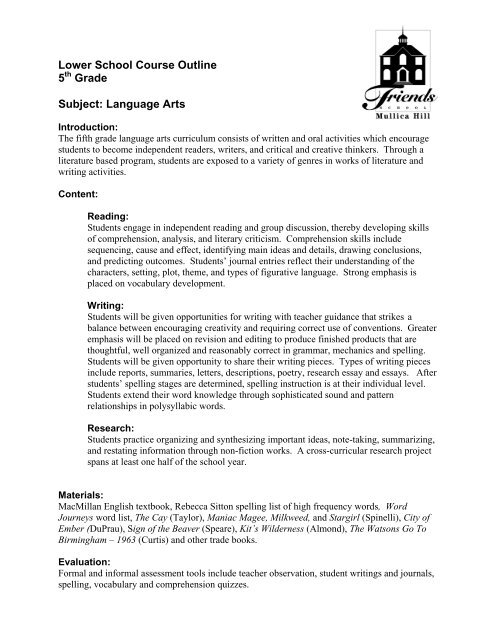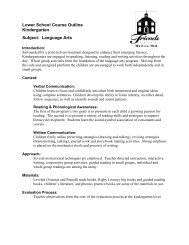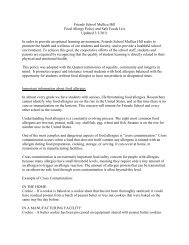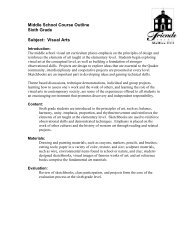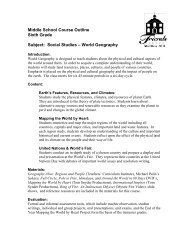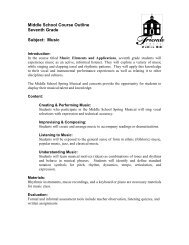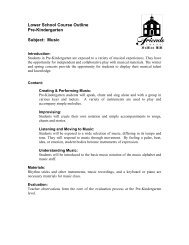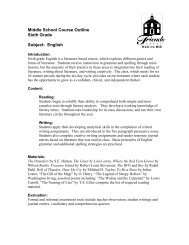5th Grade
5th Grade
5th Grade
You also want an ePaper? Increase the reach of your titles
YUMPU automatically turns print PDFs into web optimized ePapers that Google loves.
Lower School Course Outline<br />
5 th <strong>Grade</strong><br />
Subject: Language Arts<br />
Introduction:<br />
The fifth grade language arts curriculum consists of written and oral activities which encourage<br />
students to become independent readers, writers, and critical and creative thinkers. Through a<br />
literature based program, students are exposed to a variety of genres in works of literature and<br />
writing activities.<br />
Content:<br />
Reading:<br />
Students engage in independent reading and group discussion, thereby developing skills<br />
of comprehension, analysis, and literary criticism. Comprehension skills include<br />
sequencing, cause and effect, identifying main ideas and details, drawing conclusions,<br />
and predicting outcomes. Students’ journal entries reflect their understanding of the<br />
characters, setting, plot, theme, and types of figurative language. Strong emphasis is<br />
placed on vocabulary development.<br />
Writing:<br />
Students will be given opportunities for writing with teacher guidance that strikes a<br />
balance between encouraging creativity and requiring correct use of conventions. Greater<br />
emphasis will be placed on revision and editing to produce finished products that are<br />
thoughtful, well organized and reasonably correct in grammar, mechanics and spelling.<br />
Students will be given opportunity to share their writing pieces. Types of writing pieces<br />
include reports, summaries, letters, descriptions, poetry, research essay and essays. After<br />
students’ spelling stages are determined, spelling instruction is at their individual level.<br />
Students extend their word knowledge through sophisticated sound and pattern<br />
relationships in polysyllabic words.<br />
Research:<br />
Students practice organizing and synthesizing important ideas, note-taking, summarizing,<br />
and restating information through non-fiction works. A cross-curricular research project<br />
spans at least one half of the school year.<br />
Materials:<br />
MacMillan English textbook, Rebecca Sitton spelling list of high frequency words, Word<br />
Journeys word list, The Cay (Taylor), Maniac Magee, Milkweed, and Stargirl (Spinelli), City of<br />
Ember (DuPrau), Sign of the Beaver (Speare), Kit’s Wilderness (Almond), The Watsons Go To<br />
Birmingham – 1963 (Curtis) and other trade books.<br />
Evaluation:<br />
Formal and informal assessment tools include teacher observation, student writings and journals,<br />
spelling, vocabulary and comprehension quizzes.
Lower School Course Outline<br />
5 th <strong>Grade</strong><br />
Subject: Math<br />
Introduction:<br />
The fifth grade math curriculum is based on the Everyday Mathematics program. Students<br />
develop a variety of successful problem-solving strategies and techniques. This curriculum is<br />
designed to prepare students for more advanced mathematics in middle school.<br />
Content:<br />
Numeration:<br />
Students learn to identify whole numbers through the billions and decimals through the<br />
thousandths. They will also learn to identify prime, composite and square numbers.<br />
Operations and Computation:<br />
Students will compute 3 and 4 digit numbers and decimals using addition, subtraction,<br />
multiplication, and division. Students will compare, add, subtract, and translate fractions,<br />
decimals, and percents.<br />
Data:<br />
Students will collect and interpret data using graphs and basic statistics.<br />
Geometry:<br />
Students will compare, measure, and analyze geometric shapes. They will also measure<br />
and draw angles and identify angle relationships in a variety of geometric shapes.<br />
Measurement:<br />
Students will estimate and measure length, perimeter, area, volume weight, and capacity<br />
using common units of measure.<br />
Algebra:<br />
Students will evaluate and solve algebraic equations, open number sentences, and rate<br />
problems.<br />
Materials:<br />
Everyday Math student journals, Student Reference Book, Study Links, tool kits, and other math<br />
manipulatives as needed comprise the list of materials.<br />
Evaluation:<br />
Formal and informal assessment tools include teacher observation, daily journal work, student<br />
self-assessment, and periodic progress checks in the Everyday Math program.
Lower School Course Outline<br />
5 th <strong>Grade</strong><br />
Subject: Social Studies<br />
Introduction:<br />
Fifth grade social studies curriculum is designed to give students an introduction to United States<br />
geography and history. Cross-curricular projects and field trips to historical and natural<br />
landmarks consolidate processed information. A goal is for the students to become inquisitive<br />
about the events which took place before they were born, to see and appreciate history as a story<br />
that led to where they are now.<br />
Content:<br />
United States Geography:<br />
Students identify major landforms and bodies of water, study climate and natural<br />
resources. A yearlong study and review of states, cities, and important water/land<br />
features culminates with students mapping the United States from memory.<br />
The Earliest Americans & Indigenous Peoples:<br />
Students study about migration of the first people to North America. Students compare<br />
and contrast the indigenous peoples - Inuits, Anasazi, Apaches, Hopi, Navajo, and<br />
Eastern Woodland Indians.<br />
Explorers:<br />
Topics include exploration and settlement of North America by the Spanish, French,<br />
Dutch, and English. The major concepts are the motivation of the explorers, where they<br />
explored, and the results for their countries as well as effects on indigenous people of the<br />
Americas.<br />
Trade and Slavery:<br />
Students study the history and influence of the trans-Atlantic slave trade and the sugar<br />
trade on United States history.<br />
Early United States History:<br />
Students examine the formation of the New England, Middle Atlantic, and Southern<br />
colonies. Students study the events that led to the American Revolution which are<br />
examined as a series of cause and effect events. Students study the beginnings of the<br />
United States as a new nation, focusing on the structure of government, balance of power,<br />
and the Bill of Rights.<br />
Materials:<br />
History Alive: America's Past (Teachers' Curriculum Inst.), National Inspirer (Tom Snyder<br />
Productions, 1992), maps, videos, various primary source readings, trade books<br />
Evaluation:<br />
Tests, homework assignments, projects, and class participation are the basis for trimester grades.
Lower School Course Outline<br />
5 th <strong>Grade</strong><br />
Subject: Science<br />
Introduction:<br />
The fifth grade Science curriculum introduces students to a variety of topics. Students develop<br />
and use the scientific method through weekly hands-on lab activities. Teacher-led discussions,<br />
labs, and outdoor programs immerse the student in the scientific world.<br />
Content:<br />
Scientific Method:<br />
Using lab activities, students will learn to develop a hypothesis, organize results, and<br />
draw conclusions.<br />
Earth Science:<br />
Students learn about the formation of our solar system. Students study geology,<br />
including plate tectonics, types of weathering, and the formation of land features.<br />
Students discuss weather and climate.<br />
Physical Science:<br />
Students classify matter and identify its changes.<br />
Life Science:<br />
Students study ecology, biomes and issues affecting the environment. Students study cell<br />
structure and function and the scientific classification of all organisms. Students<br />
investigate the basic human body systems.<br />
Health Science:<br />
Students learn about hygiene, nutrition, and gender specific puberty topics. To promote<br />
healthy lifestyles, students participate in a trimester of yoga and in the Harrison<br />
Township’s Police Department’s DARE program.<br />
Materials:<br />
Science (Houghton Mifflin), laboratory equipment, research materials, computers, and<br />
demonstration objects comprise the list of materials.<br />
Evaluation Process:<br />
Unit assessment, lab reports, class participation and teacher observation form the basis for the<br />
students’ grades.


